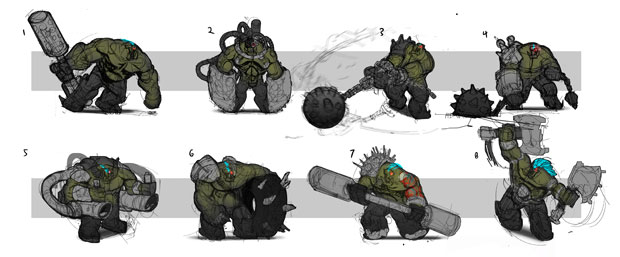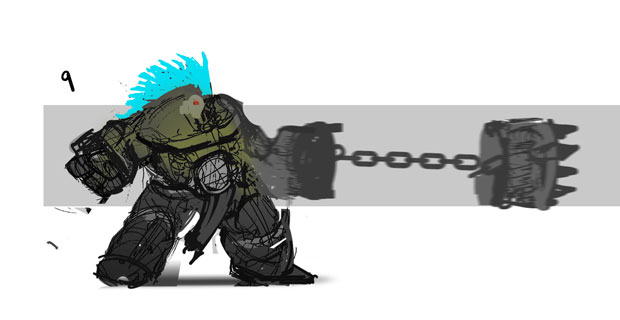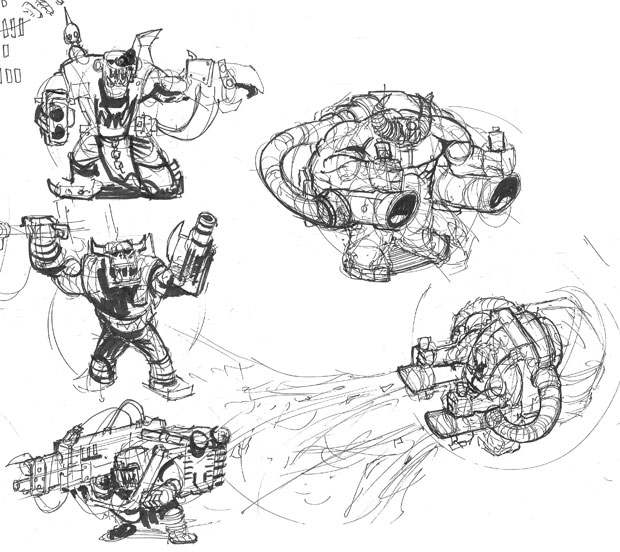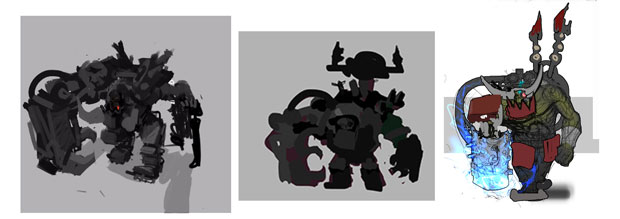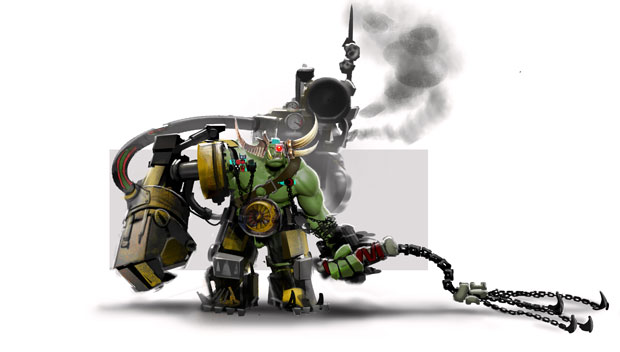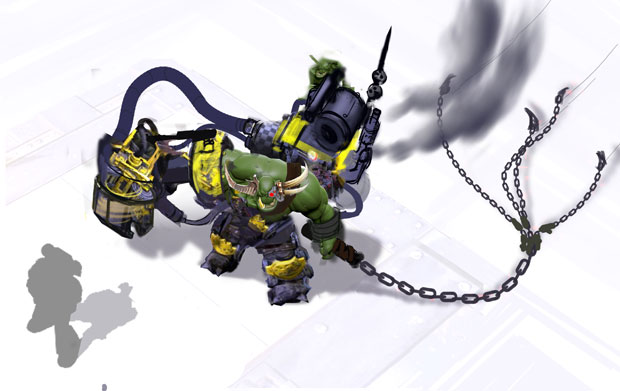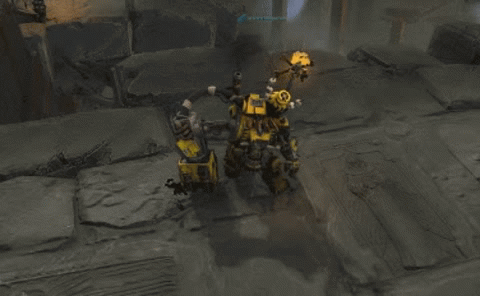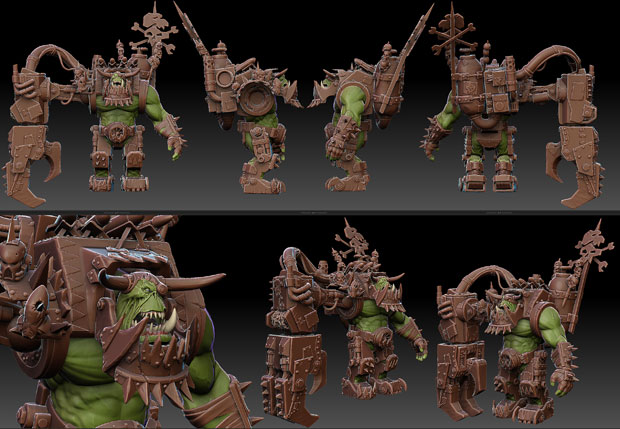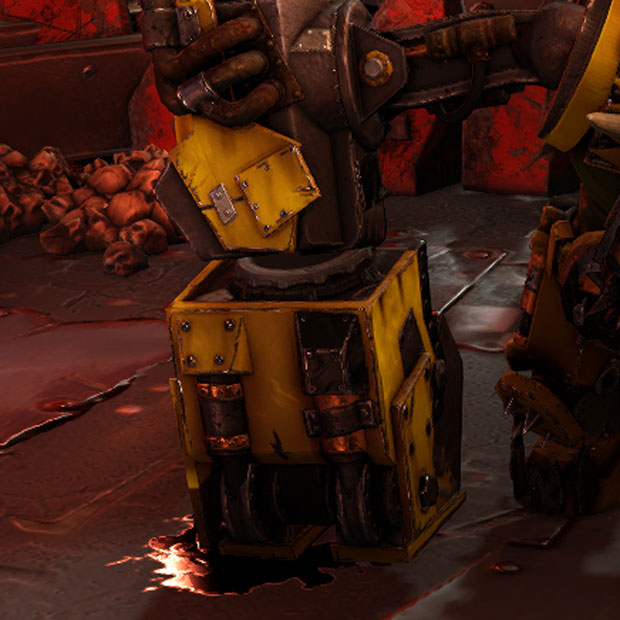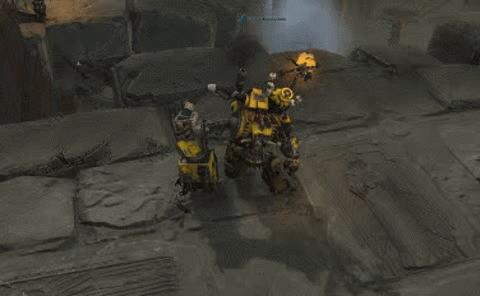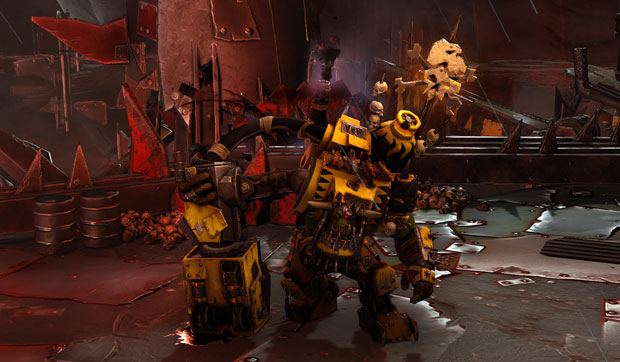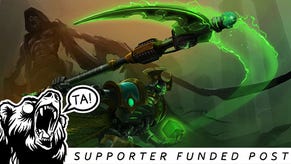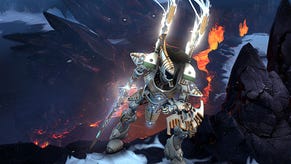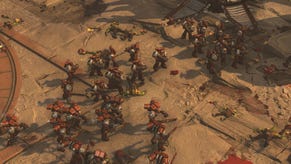Dawn Of War III: Gorgutz gets a mighty makeover
Not just 'ead 'unting
Along with the rest of the Ork faction, Dawn of War III [official site] is rolling out the red carpet – well, the battle-worn, looted and bloodspattered carpet – for a familiar face: Gorgutz 'Ead 'Unter. The warlord took a break from the franchise for the second game but is returning with a mighty power klaw and a striking yellow makeover for Relic's third game in the series. The devs are keeping schtum about most of the narrative side of things for now, but were more than happy to chat about the new look for the remodelled collector of skulls (and other shiny gimcrackery).
Art director, Matt Kuzminski, was on hand to discuss gigantic bionic arms, spiked punching fists and swaggering cubes…
The first thing to note is that Gorgutz is one of the oldest characters in the franchise. That meant that when the team wanted to bring him into Dawn Of War III there was already a model and a look in place as well as the character and personality. With that in mind there were decisions to be made about what to stick with and what to refresh.
"Second to Gabriel [Angelos] I think he's one of our most featured characters," says Kuzminski. "He was in Winter Assault, Dark Crusade and Soulstorm, I believe. He wasn't in Dawn of War II but we wanted to bring him back because he fit really well into the story. Gorgutz, to set the stage for his personality, he collects heads and sticks them on spikes on his back. So he's got all kinds of skulls, but it's not just heads. He's a collector of all things.
"The story we wrote for Dawn of War III, he's building himself back up again. I wouldn't say he's necessarily fallen on hard times but he's not at the top of his game so he's got to build himself back up and re-acquire an army for himself.
"We wanted to capture this personality we had before which was this big Ork warboss guy. He's huge, he's tough. But we wanted to bring something new to Dawn of War III and we really wanted to express his personality and character through his visuals with this big giant klaw - this power fist. It's basically saying he's got a big hand and he's grabbing everything. He's almost like a greedy child who has this oversized mitt he uses to grab everything he wants and get what he needs."
Gorgutz was actually something of an unusual opportunity for the art team in that the design team usually have a clear vision for what they want to do with a character. With the Ork Warlord they were more open to suggestion.
"They said to the art team, 'You guys come up with something interesting…'" says Kuzminski. "So it was on us! We love the opportunity to try new things. You can see with a lot of concepts we explored [different] directions. Our instincts were that he was largely melee focused; he's a big, tank-like unit. We wanted him to feel tanky and take a lot of damage and be heavy and dominant-looking on the battlefield."
Ranged concepts weren't dismissed out of hand so some of the concept sketches include two pistols akimbo or fire hoses of flame – even giant machine guns strapped over the 'Ead 'Unter's shoulders. I'm rather taken with a sketch involving a gigantic mace of some kind which, in his hands, would act as a spiked wrecking ball.
"That was cool because we liked the idea of the thing on the chain," says Kuzminski when I mention it. "We could definitely do something quite cool with that. Then the lead designer came back to us with the idea of a grappling klaw as well so he can use the klaw to pull himself towards things or pull things towards him [...]
"Then I did these really rough, blobby sketches on my iPad on the train to work one morning of Gorgutz's klaw as these greyscale silhouettes. There was something compelling about this big giant klaw the size of himself. It felt appropriate. He had a huge klaw in [the original] Dawn of War so it was like, this works, and Phil, our design director was like 'That's cool – you're onto something.' The design just kind of followed on from there."
Some of the other designs have Gorgutz weilding something in his left hand as well as the right, but the screenshot I have of the finished character ultimately leaves him with a giant klaw on the right and a free hand on the left. That's not to say a weak hand because he's a beefy Ork and the arm has a lot of metal spikes strapped onto it.
"Most of his melee attacks are focused around his klaw," agrees Kuzminski. "I actually had notes from the design team saying 'We're thinking about a ranged weapon for his hand but the strength of his melee is so impressive that it would just add noise to the overall look of him.'"
He digs out the note and the official phrasing is: "Though we could give Gorgutz a ranged weapon the design has no need for one. We feel it just adds noise."
The free hand is thus more of a useful element when it comes to expressive movements and little animated touches which help build the sense of character. For example, there's an idle animation where part of the scrappy guard he's got for his face slips down and he pushes it back up with that hand.
I showed Adam the images of Gorgutz when they came over and he was interested in knowing about the fuel canister which looms over the Ork's left shoulder. Perhaps a flamethrowing ability of some kind made it through?
"Actually, believe it or not, that was just a visual counterpoint to the klaw so he would feel a bit more balanced," explains Kuzminski. He also goes back to those idle animations to explain that the fuel tank is implied to be the power source for the klaw. One involved oil leaking out of the pipes, squirting out in little jets. "His klaw needs power and it has a lot of energy in it when he's spinning it round and using it. There's an enormous amount of electrical effects that come off of it and we felt we wanted a sense of some kind of thing powering it. There's some engine there and the large tank is fuel for it."
Something I'm interested in is the relationship between designing for an elite unit like Gorgutz and having a coherent design for the rest of the faction. Do you start with the big characters and work down or do you start with the minions and work up?
"The way we looked at it was early on in the design phase, design doesn't really have a clear idea of which heroes and elites they're going to use," he says. "We look very holistically. We generally start with the knowns in the case of the Orks or the Space Marines or the Eldar. In the case of the Orks it's the simplest line units, so the Boyz. That's generally where we start.
"I'd describe it as a layering process. We start with the simple and build up. As we add more units we build off the initial design we did for the Boyz and build up or create around the central concept we had done there. The interesting thing about that is towards the end of the project – like we are now – we realise the initial concepts we had for a simple unit like the Boyz was actually probably too complex and too sophisticated so we end up... I don't want to use the word 'simplifying'. It's more about boiling it down to the essence of the character."
Maybe streamlining is a better word. After all, Kuzminski is keen to stress nothing about those units was being dumbed down, it was more about legible designs and creating a language where you could get a feel for a unit's relative impactfulness as an individual on the battlefield by looking at them.
"Streamlining is a great word. We talked a lot in the past on this project about how we're trying to reduce as much visual clutter to the player as possible. That's very meaningful for us. It's something we really care about. So when we got to the end and the Boyz are very complex and they were creating a lot of visual noise on screen we needed to streamline that."
Legibility is a big thing for Relic's art team and they're proud of what they've achieved with Gorgutz on that front because, as Kuzminski explains it, with his big klaw he's "very readable and distinct on camera. There are other Ork units on screen that are a similar size to him but you can pick him out from them. It's very clear that you've got those guys and that's Gorgutz. You don't get confused at all. It's immediate."
Streamlining is all well and good when you've got a faction that's concerned with keeping its power armour clean and tidy (COUGHCOUGHspacemarinesCOUGHCOUGH) or not getting its fancy capes muddy (LOOKING AT YOU, ELDAR) but what about the inherent hum of visual noise that comes with the Ork habit of cobbling their battle gear together out of tat they scraped off the battleground?
"It's very, very, very challenging with the Orks," admits Kuzminski. "They are, by nature, extremely noisy and there's a lot of visual detail going on. It's funny because the Orks are probably one of our most art-heavy factions. They take an enormous amount of time. Our modelers spend huge amounts of time sculpting and creating the units so it's very challenging.
"We look at the concept, we evaluate where we're going, we block in in-game - generally speaking we try to put a greyscale proxy model into the engine and look at it from the player camera to understand what we want to see, then we say, 'Okay we're confident that's about right', then we start adding detail. That adds a whole other layer of complexity - how they move and how their silhouette interacts with other units of the same faction on screen... It's a lot of back and forth, a lot of fine-tuning.
"Even now we continue to adjust textures and add noise, reduce it... It's not simply a matter of taking away, in some cases it's adding [noise] in to define a character as more important or bigger or deals more significant damage. It's a nuanced process that takes the course of the entire project."
I want to go back to the idea mentioned earlier of characters being read in relation to one another so that impactful characters stand out more or so that game-altering abilities catch the player's eye. Gorgutz is an Elite unit in Dawn of War III while regular army units are called line units. You need to make use of both as you play, but you also need to keep track of how they're being used and where they are, hence the focus on legibility.
"What we try to do with the Elites is we budget more time to do them because they need to stand out - they're more visually complex and have more sophisticated behaviour on screen. The animation time, the effects time, the audio time that goes into them is more than a line unit.
"That doesn't mean we don't spend the necessary time with the line units [but] with line units they're much more straightforward in their function. When we build them there's nuance to the art and balance to be found but we generally get the line units to a place we're happy with and then we start [adding] Elites into that mix and the elites are much larger, they look bigger, or we have a glow on them or some kind of visual cue that they're more significant. We get a ratio of this unit looks more important than that unit. That's what we want."
So the units are adjusted in this ongoing feedback cycle, not just in terms of how they relate to one another, but also in terms of how they relate to the different tilesets used as different backdrops in the game. That means co-ordinating with environment design and with animators and so on, as well as within character art. "I cannot stress how much we iterate. Simply put, iteration is our friend."
One effect designed to stand out is when Gorgutz spins his klaw. "It's spinning this large diameter radius around him that does enormous damage to enemies, protects allies and is a bit of a game-changing moment when you're playing the Orks. For us getting that visual right was quite a lot of work."
When Adam went out to see Relic earlier in the year he told me about the animation process for some of the characters he had seen – apparently the team start with these cuboids which offer a basic form for a character and give them animations to try to feel out the right attitude or movement flow before getting into anything more complicated. I ask Kuzminski to tell me a bit more about how this process works.
"One of the earliest exercises our animation team did which was exceptionally cool is they built some blocks roughly the proportions of what our units would look like and did a very simple animation style, comparing different factions with each other to see how they would behave and how movement would inform the relationships between them and how to distinguish faction from faction."
So the Eldar were characterised by their fluidity and swiftness while the Space Marines had heaviness, tightness and discipline. Orks? Orks have a swagger and also a bit of a waddle. When Kuzminski tells me about this I stop thinking of Orks as the traditional motley greenskinned rabble and start imagining really smug, laddish ducks. Senior Animator, Nick Unden has a different creature in mind, though:
"We wanted more of an animal influence in the Ork’s look and feel. The major influence for their animation style was based on a bulldog; heavy breathing and square posture. The heavy side-to-side movement with their runs and ability was also to differentiate themselves from the upright and light Eldar as well as the heavy and hero-like movement of the Space Marines."
Once the basic animation concept is established the animation team can then take specific units and then build them up based on that initial flavour. For bigger units like Gorgutz you'd add in touches which reveal his personality or express his character in simple ways and which you can pick up on from the player camera point of view.
Using Gorgutz as an example, Kuzminski points out a few elements (here's the screenshot image again so you can see what he's referring to):
"You can see from his posture here he's very hunched over, he's got this fist that's very firmly resting on the ground. It's clear he's heavy. When he moves around you take that weight and run it through the filter of this swagger that the Ork character and movement design has. It informs how that character moves. Our animators have flavours they add to walk cycles and run cycles where the characters do a small antic every several seconds I think it is that inform how the character moves around.
"With Gorgutz there's at one point he gets tired [from carrying] the arm a little bit so he hoists it over his shoulder a bit so it rests above him and kind of waddles around and slams it down again. That was very much informed by that initial pass we did to create [factions]. A Space Marine would never do that. A Space Marine would never lift his power klaw and carry it over his head because it's just not what they do. It's not in the visual language of how they move."
Gorgutz's asymmetry was also important to note here. That enormous klaw might have ended up looking curiously light or inconsequential if it didn't seem to impact his gait or his movement. Unden tells me:
"With Gorgutz, the number one focus of his animation was the weight of his mechanical arm. Every movement, from his idles to his runs, were designed to show how heavy that arm is for him to carry around. This influenced his posture, created a lot of the asymmetry you see in the game, and re-emphasized the power of this weapon."
A question Adam sneaked into my list was about Gorgutz's 'ead 'unting ways. Specifically, he wanted to know whether the Warlord would be sporting any trophies to reference previous encounters – head-shaped Easter Eggs for Warhammer 40K fans to exclaim over...
"Believe it or not, with Gorgutz we originally had some designs around that," says Kuzminski. "They had a couple of details but they sort of conflicted with what we were trying to sell. They got a little distracting. We wanted to refocus the character [so that] what you see is what you get."
However, he goes on to point out one distinctive element of Gorgutz's new look and offer a bit of a tease: "One of the things a lot of fans might notice is that with Gorgutz, he's yellow now instead of red. That would be a contentious issue I think for some fans. In fact all our narrative Ork faction we play with in this game is yellow as opposed to red. One thing I wanted to say about that - if I can hijack the question a little bit – the point I wanted to make about Gorgutz is you'll find his allegiance is flexible. That's about the only clue on story that I can give but he's definitely a bit of a mercenary."
So his yellowness is tied into his role in the larger narrative?
"Yeah."
As we get towards the end of our time, I ask some questions just to sate my own Warhammer curiosity. One is whether Relic have built a real-life miniature of their Gorgutz. I like the idea of these things ebbing and flowing between real things you can hold in your hand and digital things you command around the battlefield. As Kuzminski tends to spend most of his days creating Warhammer art, miniature building and painting isn't currently an easy fit with his free time. Having said that, he adds "I'm building a Lego Gorgutz at home right now. My kids are huge Lego fans obviously because they're kids and so I'm building a Gorgutz out of Lego which I'm hoping to share at some point!"
I finish up by asking what he's most enjoyed about the whole Gorgutz process.
"The thing that makes me the happiest about Gorgutz is that we've got something distinct. It's not to be dismissive about the Dawn of War 1 design at all - he's an amazing character and I still know and am in touch with the people who originally created that character. But for me the thing that makes me so happy about Gorgutz is that we created something unique and distinct, which stands out against all other warbosses. There's no confusing him with someone else.
Kuzminski adds, "His silhouette will, I think, be very classic and readable for a really long time."
I love the silhouette stuff. It makes me think of those Victorian silhouette portraits in those oval mounts. I suggest Kuzminski get one for the office to mark the Ork faction's release. He takes the idea one step further:
"One of Macha and Gabriel Angelos and Gorgutz. All three of them together in those little ovals with a very ornate frame. We'll put it on our floral wallpaper that we have all over the place at Relic. We can all regard them during teatime…"
As you sit on your chaise longues?
"Exactly! And discuss dismemberment and bloody chunks of Space Marines flying about."

